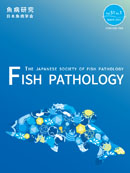
- 4 号 p. 117-
- 3 号 p. 101-
- 2 号 p. 63-
- 1 号 p. 1-
- |<
- <
- 1
- >
- >|
-
Mass Mortality Caused by Pseudomonas anguilliseptica in the Pond-cultured Ayu Plecoglossus altivelisYoshiko Shimahara, Yasuhiko Kawato, Ikunari Kiryu, Toyohiro Nishioka, ...原稿種別: Short Communication
2018 年 53 巻 3 号 p. 101-104
発行日: 2018/09/15
公開日: 2018/10/19
ジャーナル フリーPseudomonas anguilliseptica infections have not been reported in cultured ayu Plecoglossus altivelis in Japan since a few occurrences in the 1980s. In the spring of 2013, however, mass mortality was encountered at an ayu rearing facility in Akita Prefecture, Japan, and the causative agent was identified as P. anguilliseptica. In this study, biochemical characterizations and 16S rRNA gene sequences of the isolates from the present event were shown to be identical to previously reported isolates of P. anguilliseptica from ayu. LD50 of the present isolate against ayu in the infection test was 1.7 × 103 cfu/fish.
抄録全体を表示PDF形式でダウンロード (993K) -
荒川 純平, 米加田 徹原稿種別: 短報
2018 年 53 巻 3 号 p. 105-109
発行日: 2018/09/15
公開日: 2018/10/19
ジャーナル フリー2017年に愛知県の金魚卸売市場で,体表に腫瘍状の隆起のあるキンギョが1尾発見された。このキンギョの体側部には 2~4 mm程度の隆起が複数認められ,一部に出血が見られた。隆起組織の一部を採取して検鏡したところ,粘液胞子虫の胞子が多数確認された。胞子の大きさは,長さ17.1 ± 1.0 μm(平均±標準偏差),幅6.1 ± 0.7 μmで,一つの極嚢が観察された。18SリボソームRNA遺伝子の部分配列は,Thelohanellus testudineusと完全に一致した。本研究は,国産キンギョの皮膚に寄生したT. testudineusの初報告である。
抄録全体を表示PDF形式でダウンロード (1059K) -
Alkhateib Y. Gaafar, Hirofumi Yamashita, Indah Istiqomah, Yasuhiko Kaw ...原稿種別: Short Communication
2018 年 53 巻 3 号 p. 110-113
発行日: 2018/09/15
公開日: 2018/10/19
ジャーナル フリーTo develop an oral vaccination method for viral nervous necrosis (VNN) caused by piscine nodavirus (betanodavirus), sevenband grouper Epinephelus septemfasciatus was immunized with inactivated redspotted grouper nervous necrosis virus (RGNNV) vaccine. Seven-day consecutive oral administration of the RGNNV vaccine via feed failed to induce protection in fish against the virus challenge at 21 days post-immunization. However, anal intubation of the vaccine conferred protective immunity on fish, although virus neutralizing antibodies could not be detected. Similar protective immunity was also confirmed by oral administration of vaccine via feed supplemented with capsaicin, suggesting that capsaicin modulated the intestinal mucosal barrier to induce immune response.
抄録全体を表示PDF形式でダウンロード (963K)
- |<
- <
- 1
- >
- >|